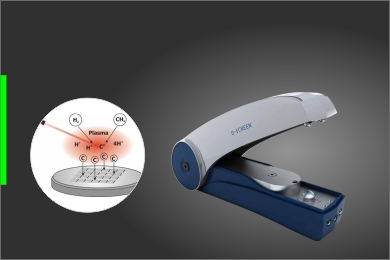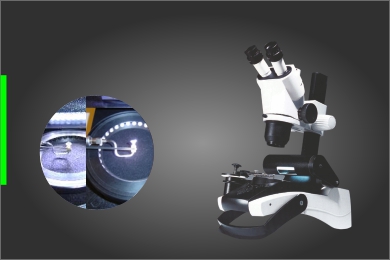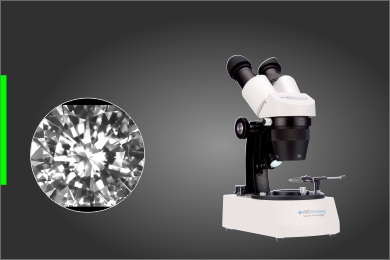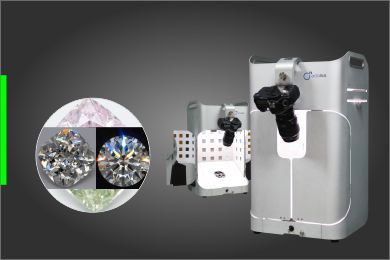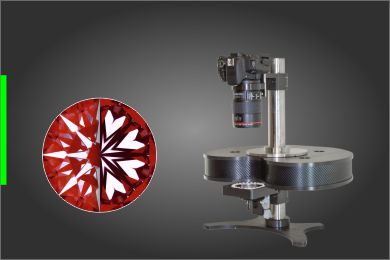ALPHA Diamond Analyzer
Home Grading & Branding ALPHA Diamond Analyzer
The ALPHA Diamond Analyzer allows you to classify any diamond within a minute. The device is easy to use wherever you want.
The ALPHA Diamond Analyzer has been designed to perform reliable diamond detection and type screening, which helps you to boost up consumer confidence. First of all, it distinguishes diamonds from imitations or other precious gemstones.In addition, its accurate and reliable determination of the diamond type allows you to select potentially HPHT treated or synthetic colourless diamonds for further testing.Finally, the ALPHA Diamond Analyzer helps you to identify specific diamond types, and consequently, to create the highest added value in gem diamond sorting and valuing.

Introduction
One of the traditional techniques used to differentiate diamonds from imitations and other precious stones is Fourier Transform Infrared (FT-IR) Absorption Spectroscopy. It is also used to classify the different types of diamonds based on impurities (nitrogen and boron). Up till now, traditional FT-IR technology has included sophisticated research-grade spectrometers. Hence, the interpretation and analysis of the FT-IR data were highly depended on experienced laboratory staff. Today, the new ALPHA Diamond Analyzer offers an automated, easy to use and dedicated solution for diamond detection and type analysis based on the FT-IR method. It distinguishes diamonds from imitations or other precious gemstones using the FT-IR diffuse reflectance method.
FT-IR spectra of diamond
Diamond shows characteristic absorption features in the mid-infrared range of the electromagnetic spectrum (4000- 400 cm-1). In diamond, there are intrinsic absorptions which are referred to as two-phonon (2665 to 1332 cm-1) and three-phonon (4000 to 2665 cm-1) bands. These absorption bands are characteristic for all diamonds. The most common diamond imitations are cubic zirconia (ZrO2) and moissanite (SiC).
Figure 1 shows the FT-IR spectra of a pure diamond, cubic zirconia and moissanite. The differences between these specific spectral patterns are obvious.

Figure 1: FT-IR spectra of a pure diamond (blue curve), cubic zirconia (green curve) and moissanite (red curve).
The region in FT-IR spectra between 1332 cm-1 to 900 cm-1, referred to as the one-phonon region, is where nitrogen impurities can produce characteristic features. As nitrogen is the most abundant atomic impurity in a diamond, the type classification scheme has been developed based on its presence. Type I diamonds contain detectable levels of nitrogen using FT-IR methods, while type II diamonds are classified as diamonds with no detectable nitrogen.
Diamonds containing nitrogen (Type I diamonds) are estimated to have an abundance of roughly 98% in the natural diamond populations worldwide. Type I diamonds are divided into type Ia and type Ib, depending on how the nitrogen impurities are arranged. When the nitrogen atoms are grouped in aggregates, the diamonds are referred to as type Ia diamonds. When the nitrogen atoms remain isolated, the diamonds are of type Ib.
Figure 2 shows the one-phonon region of FT-IR spectra illustrating the different stages of nitrogen aggregation from single isolated nitrogen atoms, also known as C-centres, (detected at ~1344 cm-1 and ~1130 cm-1), to A-aggregates, groups of 2 nitrogen atoms (detected at ~1282 cm-1) and B-aggregates, groups of 4 nitrogen atoms surrounding a vacancy (detected at ~1175 cm-1). They refer to the “pure” diamond types Ib, IaA and IaB respectively. When saturation due to nitrogen impurities occurs in the one-phonon region and A- and B-aggregates cannot be identified separately, the diamond is classified as a type Ia diamond.

Figure 2: Nitrogen impurities in diamond. The characteristic features in the onephonon region (1332 cm-1 to 900 cm-1) of A- and B-aggregates and C-centres are indicated.
Type II diamonds are considered as the purest form of diamond from an atomic point of view. Type II diamonds are subdivided into types IIa and IIb. Type IIa diamonds do not contain any detectable nitrogen or boron using FT-IR methods. This group is very rare in nature (approximately 1% to 2% of all diamonds).
Type IIb diamonds (< 0.1% of all diamonds) have substitutional boron atoms in the crystal lattice. As a result, these diamonds are blue, although they can also be brown and grey to near-colourless.
A schematic diagram illustrating “pure” type I and II diamonds is shown in Figure 3.

Figure 3: Diamond type classification is based on the presence or absence of nitrogen and boron impurities and their specific configurations in the diamond lattice. Note that this diagram only shows “pure” diamond types. Note that most diamonds are of mixed types.
The diamond type classification scheme not only provides a useful way to categorize diamonds, it can do much more. The type of a diamond also provides valuable information on its history. This may refer to the geologic conditions to which natural diamonds have been exposed in the earth or to the laboratory conditions during treatment or synthesis.
In recent years, the production and the quality of synthetic gem diamonds have increased dramatically. In particular, significant developments in the chemical vapour deposition (CVD) method have led to the introduction of high quality (near-)colourless and good clarity CVD synthetic diamonds in the gem market. CVD synthetic diamonds are most commonly of type IIa.
Synthetic diamonds can also be grown with the High Pressure High Temperature (HPHT) method. Since the seventies, gem quality diamonds have been produced by HPHT synthesis. The majority of these stones are coloured bright yellow to orange due to the presence of nitrogen atoms in the lattice. However, it is possible to grow colourless HPHT synthetic type IIa diamonds but technical problems make them practically absent on the diamond market. All known colourless to near-colourless CVD or HPHT synthetic diamonds are of type IIa.
In addition, it is also well known that brownish type II diamonds can be subjected to a HPHT treatment to reduce or remove the brown colour component, making them appear colourless. Note that natural type IaB diamonds are also potentially subjected to HPHT treatment to enhance the colour or to make them more colourless.

Table 1: Occurence colourless to near-colourless diamonds in relation to the diamond type.
In Table 1 the occurrence of natural, synthetic and HPHT enhanced colourless and near-colourless diamonds in relation to the diamond type is summarized. For the final conclusion on the origin of the diamond (natural or synthetic) and the origin of the colour (natural or HPHT treated), all colourless type II and I aB diamonds have to be submitted to a reputable lab for further testing. Moreover, fancy colour diamonds should always be submitted to a reputable laboratory for examination.
Therefore, the identification of the diamond type is critical. With the increasing availability and complexity of treated and synthetic diamonds, all stakeholders (from diamond exploration to diamond sorting, diamond traders and gem certification laboratories) will benefit from an adequate identification of the diamond type, enhancing consumer confidence.
Significant economic implications are at stake when considering type II diamonds. It is known that type II diamonds can be highly valued, frequently receiving the best colour and clarity grading for gem and jewellery purposes. Moreover, most large diamonds ever found (such as the Cullinan and the Koh-I-Noor) are type II diamonds. This is in distinct contrast to their low global incidence of only 1% to 2% in smaller sizes. Therefore, the presence or absence of type II diamonds can be a critical factor in the sorting and valuing of diamond parcels or in mining a diamond deposit.
| Weight | 7 Kgs. |
| Spectrometer | Dedicated ALPHA FT-IR |
| Dimension | 22 x 30 x 25 cm (w x d x h) |
| Module | Price in € |
|---|---|
| ALPHA Diamond Analyzer | € 00,000.00 |
| ALL THE PRICES ARE EX-WORKS, SURAT, EXCLUDING FREIGHT, INSURANCE, PACKING & FORWARDING AND TAXES. | |
